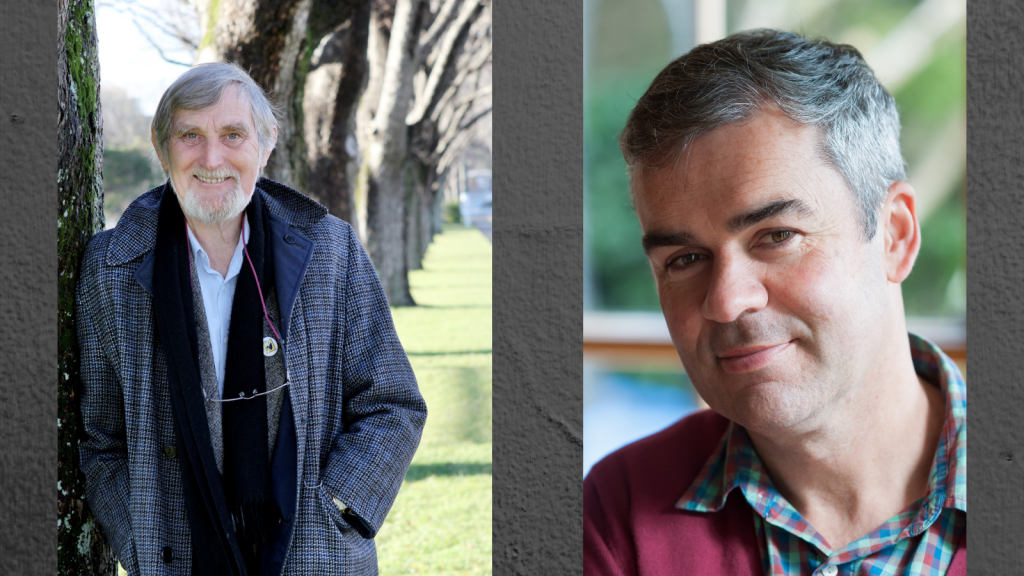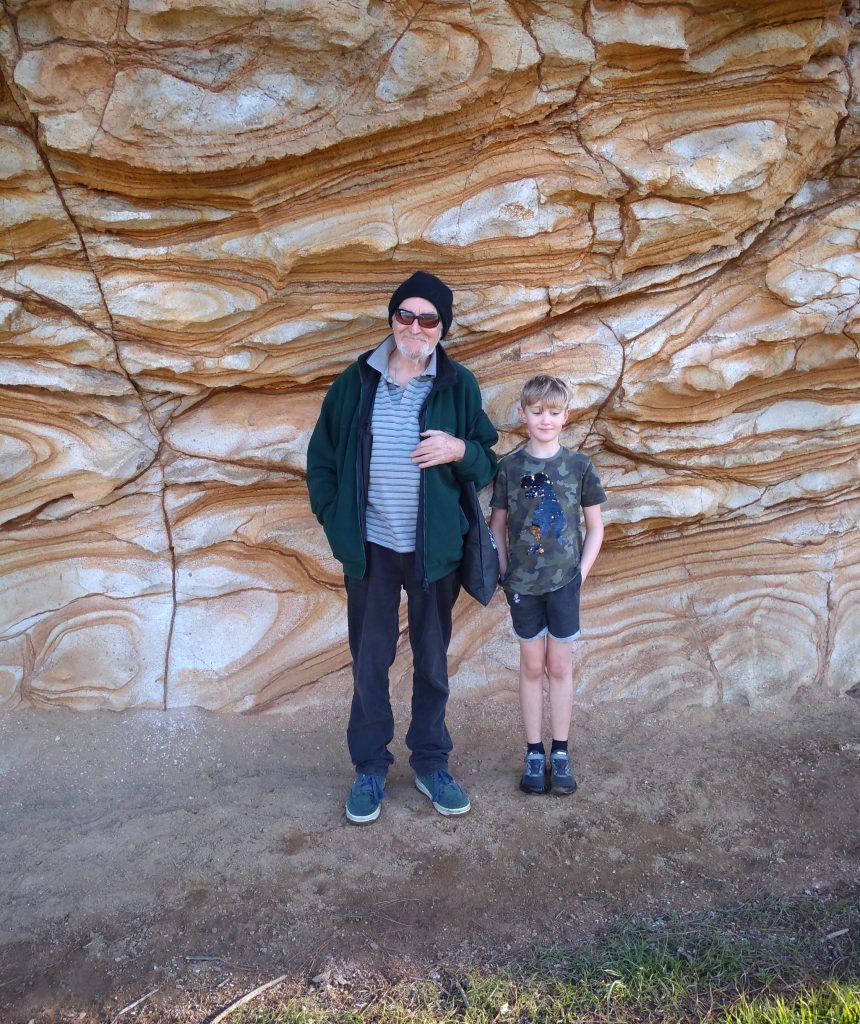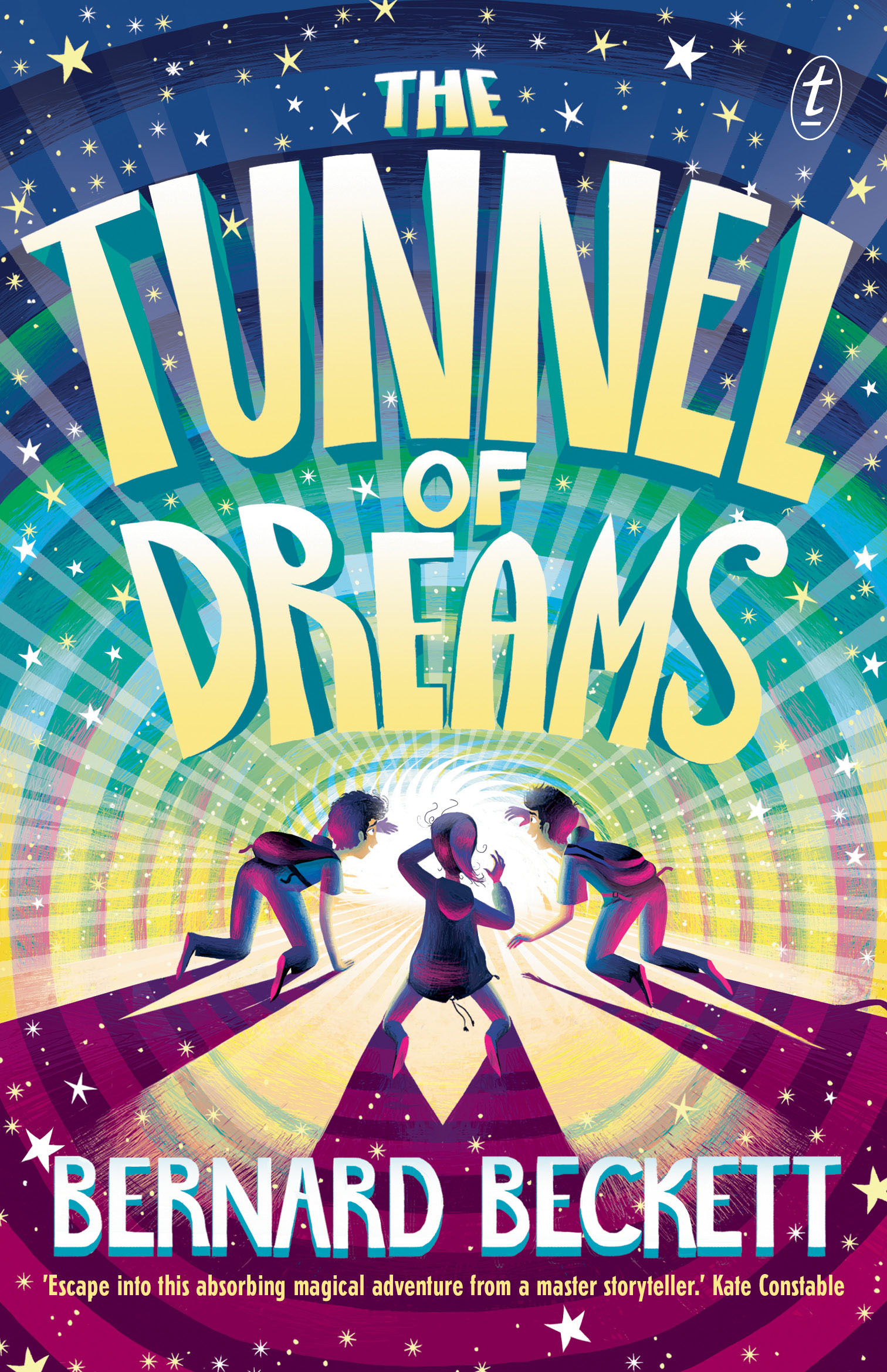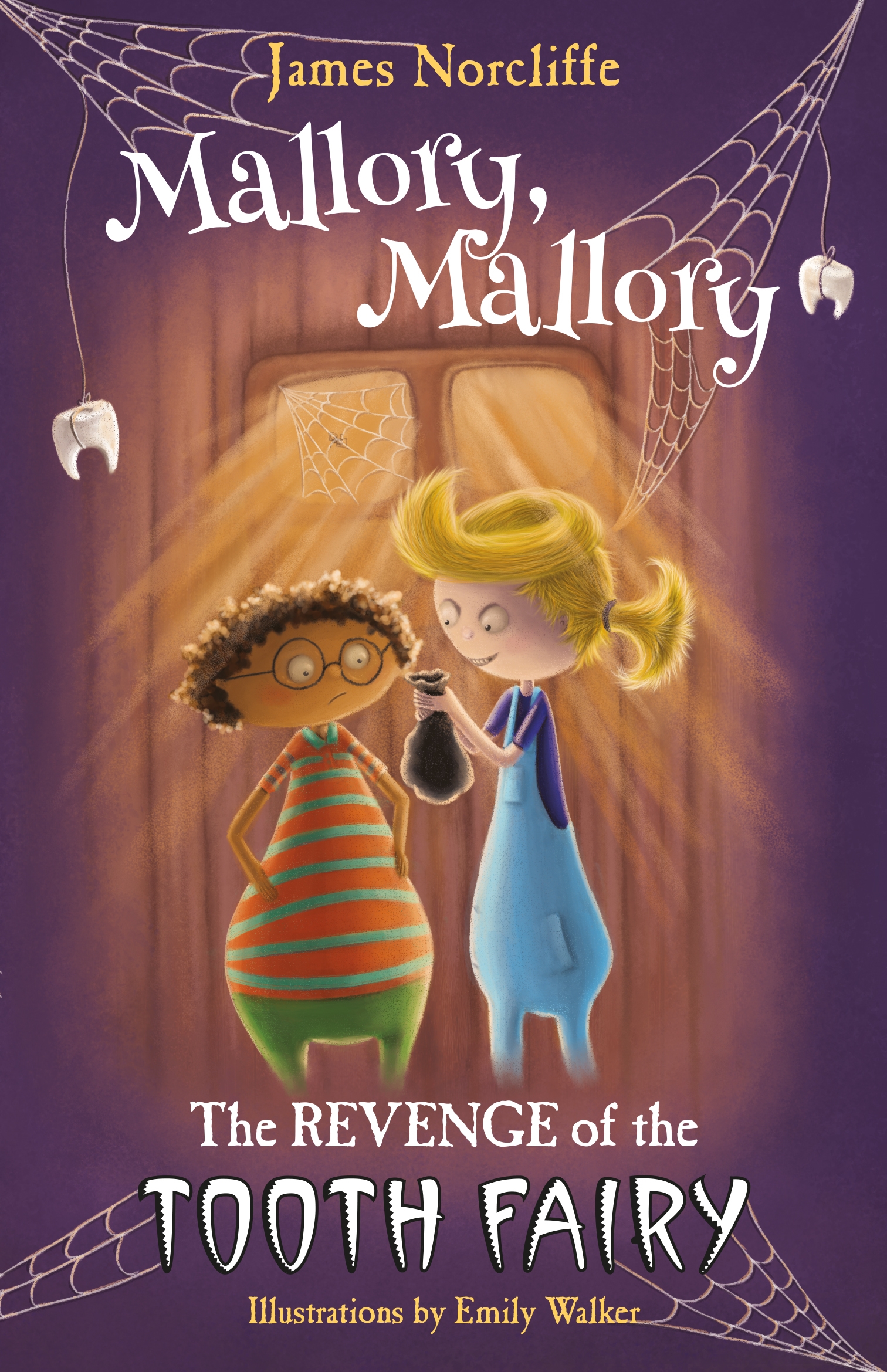James Norcliffe and Bernard Beckett are both—among other things—heavy hitters in the chapter book space, telling stories that are thought-provoking, engaging and eminently compelling to read. So with both these chaps releasing new junior fiction titles this September, we thought we’d get them to undertake one of our famous author co-interviews—and happily, they obliged!

James: First up, Bernard, let me say how much I enjoyed Tunnel of Dreams. I found it great fun, fast moving, a nicely judged mixture of light and dark, and full of plot twists and surprises. I have to say I devoured it in one sitting, despite a gloriously sunny and inviting day outside.
It’s also something of a departure for you, isn’t it? It’s aimed at readers younger than your usual catchment, and it’s also a full-blown fantasy, a genre I’m an absolute sucker for.
From your bio I note that your and Clare’s twin sons are about ten right now. The two heroes of Tunnel of Dreams are identical twin boys, Arlo and Stefan. I’m sure you won’t tell me there’s no connection? Would you like to tell us how Tunnel of Dreams came about and about the decision to write fantasy?
Bernard: Just read Mallory and the Tooth Fairy’s Revenge. Great rollicking fun from beginning to end. I can imagine kids loving the journey.
Yes, Tunnel of Dreams was very much a home project. It was written for my two boys, when they were seven, I think. We read to them each night, and still do. I thought I’d write them their own bespoke bedtime tale, involving, of course, two twins with their names, ages and sensibilities. I wrote and told it gradually, and often they’d suggest a new turn or event along the way. That, of course, didn’t lead to a publishable work, just a scattered, shambolic contribution to family lore.
It was written for my two boys, when they were seven, I think. We read to them each night, and still do.
Later I thought it’d be fun for them if I could get it published, so I beat it into shape a little, made it more coherent, and then the publisher had their own opinions, as they will. They upped the age of the protagonists, brought in a little more jeopardy for the ride (although they wanted a much lighter ending), and then pushed to have the writing simplified. That’s a pretty good metaphor for how markets work in general, I think. I love the idea of the boys having that book forever, knowing where it came from, and remembering the nights of it being read to them. The names are changed now, at their request, but I hope they’ll always remember the tale fondly.
And so to your book. It’s an interesting thing, isn’t it? How on earth do we find the level for kids, clearly not being kids ourselves. How do you find the right kind of pacing, plot interest, language and ‘vibe’, for the intended age group? Do you find publishers have their own folklore on this: seven year olds like…? Is it intuitive for you? Do you have youngsters you test it out on? Teens are easier for me, because I work with them every day, but children are more of a mystery. I’m interested to hear how you approach that.
J: I really want to say, ‘Snap!’ as my first book for children, Under the Rotunda, followed a process not unlike your writing for your two boys. In my case, the story came to me as a gift when I was playing around with the word ‘rotunda’ while walking our crazy dog. Somehow I spun a silly story involving a miniaturised brass band, an inept magician and all sorts of shenanigans in Hagley Park. I was so taken with the idea I went immediately to my computer and tapped out the first chapter. I showed it to my 9 year-old daughter, Lissie, who ran away with it and came back not long after with the magic words: ‘What happens next?’
I showed it to my 9 year-old daughter, Lissie, who ran away with it and came back not long after with the magic words: ‘What happens next?’
I’d gotten such a kick from her asking what happens next, I made sure the next chapter would leave her hanging as well, and so on it went—at breakneck speed really. Not the same sort of collaboration as with your boys, but certainly audience interaction. Lissie gave me a very good lesson in narrative drive and cliff-hanger moments.
I feel pretty comfortable writing for the upper primary age group, having interacted plenty with them through running two-day writing workshops with ‘Write On: School for Young Writers’ here in Canterbury. Like you, I’d been a secondary teacher for most of my working life. These workshops have given me direct access to my catchment, although to be honest, I’m not sure how useful this access really is. If there is influence it’s probably subterranean.

I think mainly I try to write the sort of books I would have liked to read when I was that age. I was a big reader as a kid and there were books I’d read and read again. Of course, that leaves the problem of language—it’s hard to make sure your idioms are up-to-date. The trouble is, if you’re too up to the minute, the language quickly becomes dated and last season’s fashion.
While I write with an adult sensibility, we should never underestimate kids’ intelligence. We are writing for readers, after all, we can’t patronise them. I’m sure it’s not something you would ever be accused of. Genesis with its big ideas and sophisticated debate about AI respects its audience and that is how it should be. Incidentally, when my book The Loblolly Boy was published in the States the publishers insisted on re-titling the book The Boy Who Could Fly. The reason? Because American kids wouldn’t know the meaning of the word ‘loblolly’ they would neither buy nor borrow the book from the library.
While I write with an adult sensibility, we should never underestimate kids’ intelligence.
This raises other questions about the audience—local, international—and who we are writing for. Tunnel of Dreams was published by Text, an Australian company, but it is replete with New Zealand local colour, the birds for instance. Your thoughts?
B: It’s really interesting the way books are adjusted to different markets. There is always that urge from publishers to cleanse books of specifically grounded references that may confuse readers (pukeko versus swamp hen, for example). I have a strong opinion on this. I think that when the cultural premise becomes that difference is incomprehensible, we’re in all sorts of trouble. At its worst, global connection can translate into a kind of infantilising of us all. I think of the tourists rushing for the nearest McDonalds because they know there will be the security of the absolutely predictable, while all about them the world bursts at the seams with local colour. That’s a dismal picture.
I think of the tourists rushing for the nearest McDonalds . . . while all about them the world bursts at the seams with local colour.
Literature has a wondrous ability to help us understand the strange, and a soaring narrative emerges: that beneath all the quirks and difference and strangeness of custom, there lurks the same human spirit, the same set of concerns. To me, the idea that through difference we find connection, is absolutely vital to the modern world.
I agree that we shouldn’t underestimate our readers. When it comes to the young, the story tradition is very much one of introducing them to the norms of the adult world. In this way our shared stories bind us, so we ought to be prepared to introduce the young to challenging concepts and themes, within the safe context of a story. It’s a way of them learning to negotiate the world as they experience it. This is something I’d be interested to know your thoughts on, because it’s an area where my thinking has changed significantly during my time as a writer: is the moral content of our stories.
When it comes to the young, the story tradition is very much one of introducing them to the norms of the adult world.
Do we have an obligation as writers for the young to take this lead in creating the shared moral reference points, or rather is it simply enough to entertain, or reflect society back at them? Do you feel a special responsibility when telling stories to the young, when it comes to moral guidance, for want of a better term? Or does this jeopardise the story’s authenticity?
J: We learn by exposure to what we don’t know, not by being reminded of, and comforted by, what we already know. I thought your analogy with McDonalds was spot on. McWriting.
This patronage goes well beyond vocabulary, into the realm of ideas and understanding of character. As mentioned, over the last few years I’ve spent a lot of time taking writing workshops with 10–12-year-olds and for the last nearly twenty years I’ve been selecting and editing teenage writing for the ReDraft series. I’m constantly blown away by the sophistication of the best of this material: the appreciation of ambiguity, the understanding of moral dilemma, the wonderful imagination and the poetic leaps and somersaults. It is very humbling, and a solid reminder that if this is the quality of writing these young people are capable of, why would they not prefer the same sort of quality in their reading?
It is very humbling, and a solid reminder that if this is the quality of writing these young people are capable of, why would they not prefer the same sort of quality in their reading?
All the same, I’m a little wary of ‘moral guidance’. I just wanna have fun. Fiction is such a powerful medium. It can be very manipulative. I do warn the kids in my writing classes about this. It’s easy to construct a story teaching that crime doesn’t pay, or that virtue is ultimately rewarded, etc, but it’s equally easy to construct a story demonstrating the reverse. Best, as you suggest, to be prepared to introduce challenging concepts and themes with believable characters, situations and outcomes. That doesn’t mean realism or naturalism necessarily. Fantasy can do this just as well, even comic fantasy. Always remembering, as Lloyd Alexander once said, ‘that the muse of fantasy wears good, sensible shoes’.
The special responsibility I feel when telling stories to the young is that the book’s moral compass, is not askew, and to avoid the specious and the tawdry. Of course, I have no problem when Trumpish behaviour—as in Mallory – gets its comeuppance. In fact, I quite enjoy the deliciousness of it.
B: With regard to the ethical element of writing for young minds, I have genuinely swung 180 degrees on this one. Early on when writing, I think I’d seen so many attempts at moral stories fall flat, I was resolutely of the mind that there was something inherently false about trying to fashion uplifting stories or promote particular moral standpoints.
Having taught for many decades I’m increasingly of the opinion that our young people suffer from not having access to enough stories that are inherently aspirational. It seems to me that hope, and a belief that goodness can prevail, or indeed that the very notion of goodness is itself meaningful, are must-haves, while cynicism seems to reign. The current generation are finding it more difficult to access hope, and we’re seeing this in schools, as more kids than ever before struggle with their mental health.
The current generation are finding it more difficult to access hope, and we’re seeing this in schools, as more kids than ever before struggle with their mental health.
So I’ve developed a new respect for those writers who manage to create uplifting narratives that don’t descend into a kind of parody of earnestness. The difficulty is, aspirational endings are much harder to construct; there are infinitely more ways of breaking a thing than of putting a thing together.
J: I recall modern morality plays were big in in teenage fiction in the 90s … my agent of the time (the late Ray Richards) tried to wean me off writing fantasy (it’s passé—nobody wants it any more) to concentrate instead on writing ‘issues books’ (broken homes, alcoholic parents, unwanted pregnancies). I tried, but I was an abject failure with a tug-of-love story involving a divorced father (in a gorilla suit, I couldn’t resist that touch) snatching his son off the street. And then Harry Potter arrived and—joy!— fantasy was back.
. . . my agent of the time tried to wean me off writing fantasy (it’s passé—nobody wants it any more) . . .
I do completely get what you say about having come 180 degrees on the moral value of good fiction for kids though. It’s a pretty nasty world out there with dubious role models and ‘influencers’ everywhere. The attitudes and ‘values’ flaunted on social media, on radio, music, and, a lot of badly-written ‘gross out’ books for kids—even little kids—are very depressing.
So, yes, the books we write should endorse positives: hope, redemption, all the old verities. By that I mean honesty and a moral compass. We live on a precious planet and more than ever, it needs hope, poetry, imagination, and good books. Keep writing them, Bernard, even though, as you say, it’s not easy.



James Norcliffe
James Norcliffe is a poet, fiction writer and educator. He has written collections of poetry and short stories, and several books for young adults. His writing has been featured in journals and anthologies, and he has also worked extensively as an editor. Norcliffe has won awards and prizes, and has been the recipient of prestigious fellowships, including the 2006 Fellowship at the University of Iowa. For his children’s book The Loblolly Boy (2009), Norcliffe won the Junior Fiction Award at the 2010 New Zealand Post Book Awards for Children and Young Adults.



